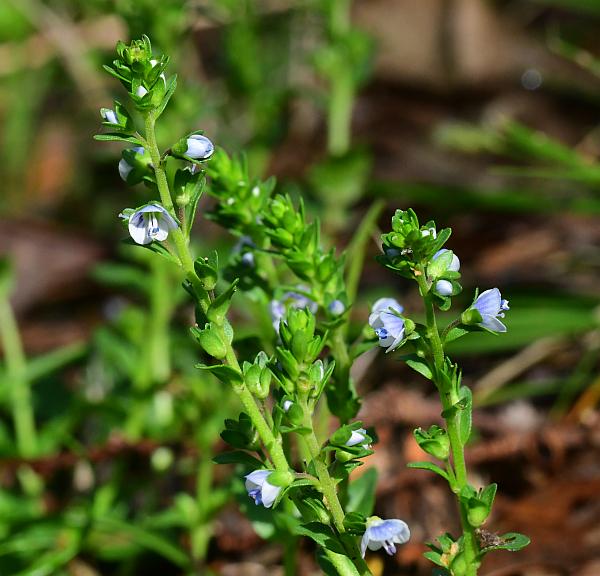Veronica serpyllifolia L.
Thyme-Leaved Speedwell

Introduced
CC = *
CW = 0
MOC = 17
© SRTurner
Veronica serpyllifolia L.Thyme-Leaved Speedwell | |
 |
Introduced CC = * CW = 0 MOC = 17 |
© SRTurner |
|
Family - Plantaginaceae Habit - Rhizomatous perennial forb from fibrous roots. Stems - Decumbent, 10-30 cm long, the tips or flowering branches ascending from prostrate main stems, moderately pubescent with short, curly or upcurved, nonglandular hairs.
Leaves - Opposite, simple, very short-petiolate to sessile. Blades 0.8-2.5 cm long, 1-2 times as long as wide, elliptic to ovate, broadly ovate, or nearly circular, broadest at or below the midpoint, rounded to broadly and bluntly pointed at the tip, broadly angled to rounded or nearly truncate at the base, not clasping the stems, the margins unlobed, flat, entire or sparsely and very shallowly scalloped, the surfaces glabrous or sparsely hairy with short, curved or curly, nonglandular hairs, these sometimes only along the veins and/or margins.
Inflorescence - Terminal bracteate racemes with 5-20 flowers, the axis usually visible between the flowers, the bracts 2-6 mm long, noticeably smaller than the foliage leaves, linear to narrowly lanceolate, narrowly oblanceolate, or lanceolate. Flower stalks 2.5-5.0 mm long at flowering (to 8 mm at fruiting), strongly ascending at flowering and fruiting. Bracts and flowers alternate along inflorescence axis.
Flowers - Calyces 2-4 mm long, the lobes slightly unequal, the upper 2 lobes slightly shorter than the lower 2 lobes, deeply 4-lobed, the lobes narrowly ovate to elliptic or oblong-elliptic, minutely glandular-hairy, often mainly along the margins. Corollas zygomorphic, 4-lobed, 4-8 mm wide, 2.5-4.0 mm long, white with blue or purple veins, the throat densely hairy, the tube appearing relatively broad, wider than long, the lobes loosely ascending to broadly bell-shaped. Style 2.2-3.0 mm long at fruiting. Stamens 2, erect, exserted, alternate and adnate between lateral and central lobes. Filaments to 3 mm long, clavate, white, glabrous. Anthers purple. Ovary superior, glandular-pubescent, globose, green, 1.2 mm in diameter, 2 locular, many seeded. Placentation axile.
Fruits - 2.8-4.0 mm long, wider than long, heart-shaped in profile, flattened, the notch shallow to moderate (0.3-0.8 mm), the surfaces and margins sparsely glandular-hairy. Persistent style nearly as long as fruit. Seeds numerous, 0.6-1.1 mm long, strongly flattened on both sides, the surfaces appearing smooth or nearly so (faintly and finely pitted), brown.
Flowering - April - August, sometimes again in the fall. Habitat - Streambanks, bottomland forests, lawns, grassy places, roadsides, open disturbed areas. Origin - Native to Europe. Lookalikes - Other species of Veronica. Other info. - This little species can be found in in a handful of Missouri counties mostly in the southeastern corner of the state. It is more common in the northern U.S. Midwest and Northeast. It is easily recognized as a Veronica by the small 4-lobed flowers and heart-shaped fruits. Identification to species can be a little trickier. This species is characterized by having discrete terminal inflorescences. These are defined by alternate bracts which are noticeably smaller and narrower than the leaves. The flowers are white, with a variable degree of blue veining. The plant can form mats if left undisturbed. Photographs taken near Creve Coeur Lake, St. Louis County, MO, 4-23-2016, and at Babler State Park, St. Louis County, MO, 4-24-2020 (SRTurner). |